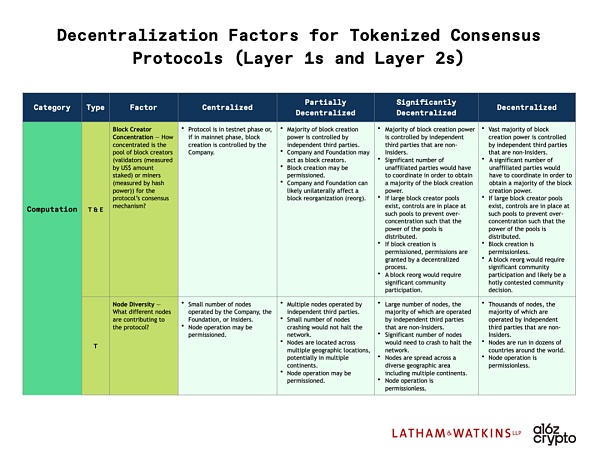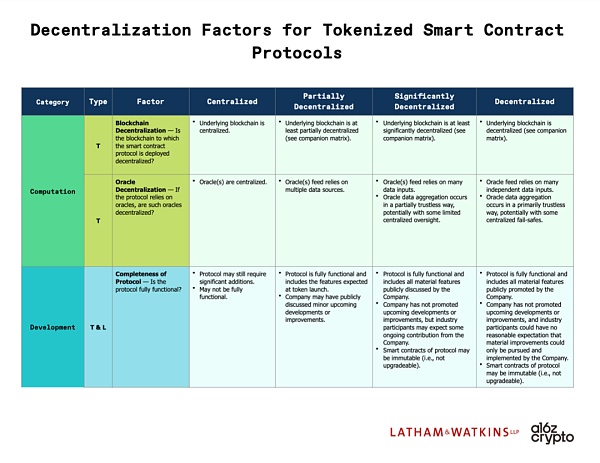A16z: Decoding the Key Elements of Decentralization in Web3 Protocols, Driving Decentralized Tools
A16z: Understanding Decentralization in Web3 Protocols to Drive Decentralized ToolsAuthor: Miles Jennings, Stephen Wink & Adam Zuckerman, translation: Sissi
Decentralization is a key innovation brought about by blockchain technology and is also one of the most important features of web3 protocols. Therefore, in order to more accurately assess and compare the degree of decentralization of various web3 protocols, web3 participants, policymakers, and regulatory agencies must collectively form a more unified and detailed understanding of decentralization. Doing so can not only better enable the regulation and policies of web3 to adapt to the characteristics of decentralization, understand and consider how decentralization reduces risks, but also ultimately encourage web3 builders to pursue decentralization to maximize the public interest promised by web3.
To this end, we have defined three types of decentralization and put forward relevant elements for each type, applicable to tokenized blockchain protocols (such as Bitcoin, Ethereum, Polygon, Solana, Optimism, Arbitrum, zksync, etc.) and tokenized smart contract protocols deployed on blockchains (such as Uniswap, Aave, Compound, Curve, etc.). We also provide two tables, one for tokenized blockchain protocols (Figure 1) and the other for tokenized smart contract protocols (Figure 2), which will help list the components of decentralization to provide more specific and standardized definitions.
For the decentralization analysis of blockchain or smart contract protocols, all relevant situations related to the protocol must be considered. The elements we propose here are intended to provide a direction for such analysis.
- Quick overview of the four potential GameFi protocols that may experience explosive growth: Treasure, MapleStory Universe, Questify, and Pixels.
- How has the NFT lending protocol Blend, under Blur, performed in the first month?
- Analysis of the entire process of the Twitter celebrity Ben’s “fraud incident”: Do investors really have “too much money and too little sense”?


Why Decentralization is Needed?
Web3 leads a new era of the Internet – the era of “read, write, and own”. The technology that supports web3 achieves “trustless computing”, no longer relying on centralized entities to browse the Internet and databases. This allows us to develop more complex and advanced protocols that can provide the functionality of modern internet and can be truly owned by users. For example, a decentralized social media protocol can support the construction of multiple applications and distribute ownership and control of the protocol to a large number of developers and users through token ownership.
Decentralization is a key feature of web3 protocols that drives this paradigm shift. Decentralization will drive the creation of a democratized internet and deliver three important changes: promote competition, protect freedom, and reward stakeholders.
First of all, decentralization makes web3 systems neutrally reliable (1) (they cannot discriminate against any individual stakeholders or stakeholder groups), which is crucial for incentivizing developers to build applications within the ecosystem. They are also composable (2) (like Lego bricks, software components can be mixed and matched). Therefore, web3 systems are more like public infrastructure than proprietary technology platforms. Unlike closed software in web2, web3 protocols provide distributed internet infrastructure that anyone can build and create internet businesses on. Importantly, this can be done without the permission of the original protocol deployer or using centralized control interfaces. For example, Twitter can be compared to a web3 protocol that provides a social media underlying data architecture controlled by the public through token ownership. In such a system, anyone can build their own client or application on top of the protocol and gain access to its user network.
This concept is quite abstract. Consider a schematic of the web3 ecosystem, which includes a decentralized blockchain, a decentralized smart contract protocol managed by DAO token holders, and several proprietary clients that operate as independent businesses using traditional entity forms. Each blockchain and smart contract protocol functions as decentralized internet infrastructure, upon which businesses can build, compete, and innovate.

Secondly, decentralization requires that control and participation be widely distributed in web3 protocols, ensuring that the development and use of the network reflect the views of a diverse range of stakeholders, not just the companies that created these protocols. By properly designed protocols that promote decentralization, power can be limited from being concentrated in the hands of one or a few companies. Therefore, decentralization should limit the control of the threshold by enterprises or individuals and ensure that any changes to the protocol are consistent with a broad user ecosystem that holds tokens and ultimately manages the network.
Thirdly, decentralization enables the design of systems that are more stakeholder-capitalist – systems that are designed to more fairly serve the interests of all participants, rather than just a particular subset. Token-incentivized stakeholder capitalism distributes ownership and control to a wider set of stakeholders, rather than placing equity holders above all other stakeholders (including customers and employees). As a result, web3 protocols and networks become a diverse design space for more fairly serving the interests of all stakeholders. Such decentralized protocols provide a more stable internet infrastructure, enabling a wider set of stakeholders to build with confidence.
Decentralization Types
We can look at decentralization from three different but interrelated angles: technical, economic, and legal. All three angles are important, but they often compete with each other and thus present complex design challenges in maximizing overall decentralization and utility.
#Technical Decentralization (T)
Technical decentralization primarily concerns the security and structural mechanisms of web3 systems. Programmable blockchains and autonomous smart contract protocols can support technical decentralization by providing a self-sovereign, permissionless, trustless, and verifiable ecosystem for value transfer. Products and services can be deployed and run without relying on trusted, centralized intermediaries, opening up vast possibilities.
For blockchain protocols, technical decentralization is an extremely challenging problem that requires balancing multiple competing forces. However, for smart contract protocols, this type of decentralization can be achieved relatively quickly and easily by making smart contracts immutable (i.e., uncontrollable and un-upgradable by anyone).
#Economic Decentralization (E)
Blockchains and smart contract protocols, through their native tokens, unlock the potential for these open-source and decentralized systems to have their own decentralized economies (i.e., autonomous free-market economies), enabling more people to participate and benefit from these decentralized ecosystems.
By making careful design decisions, builders of web3 systems can encourage the formation of decentralized economies, exchanging and aggregating value from various sources (including informational value, economic value, voting power, etc.). If constructed correctly, decentralized ecosystems can incentivize participants to contribute value to the ecosystem with token incentives and distribute value more fairly to the system’s stakeholders based on their contributions. To achieve this, web3 systems need to grant power, control, and ownership to the system’s stakeholders (through airdrops, token distributions, decentralized governance, etc.). As a result, the value of the entire ecosystem will belong to a wider set of participants, rather than being concentrated in a central entity and its shareholders.
A sustained balance of incentives among stakeholders (developers, contributors, and consumers) can drive more value contribution to the entire system, benefiting everyone. In other words, this is all the benefits brought about by the modern network effect (5) without the downsides of centralized control and closed economy.
#Legal Decentralization (L)
Legal decentralization depends on whether the decentralization of a system eliminates the risks that specific regulations are intended to address.
For example, a technically decentralized blockchain and smart contract protocol can eliminate risks associated with trusted intermediaries. As a result, such systems are legally decentralized because technical decentralization means that they are legally decentralized when it comes to regulations that target trusted intermediaries.
For technical and economic decentralization, other risks can also be eliminated, including those related to tokens in web3 systems and their potential value. Such decentralization will eliminate the need to apply US securities laws to token transactions, which could otherwise severely restrict the widespread distribution of tokens.
According to the SEC’s guidance, we can define legal decentralization as when a web3 system can eliminate potential risks of important information asymmetries and does not rely on significant managerial efforts by others to drive the success or failure of the enterprise. Once this threshold is reached, the system may be considered “sufficiently decentralized,” and therefore tokens for that system need not be subject to US securities laws. As a threshold question, this requires that a specific token does not confer any contractual rights on holders relating to the continuing efforts, assets, income, or resources of the issuer or its affiliates.
Decentralization Elements
In web3 systems that use native tokens, all three types of decentralization – technical, economic, and legal – must be fully considered. These types interact with each other, and changing one may affect the other two. For example, decentralized economy can drive the system towards legal decentralization by prioritizing decentralized ownership of stakeholders, value accumulation from decentralized sources, and value distribution to decentralized stakeholders. All of these factors reduce information asymmetry risks and reduce reliance on personal management efforts.
Conversely, if the value of a web3 system’s digital assets depends on ongoing management efforts by the original development team, the system’s decentralization at the technical, economic, and legal levels may be threatened. For example, the departure of the management team may exert huge downward pressure on the price of digital assets, making the system more vulnerable to the impact of 51% (6) attacks.
Given this interdependence, we decompose decentralization into many factors that may influence it. Figures 1 and 2 present comprehensive lists of the most important elements of tokenized consensus blockchain protocols and tokenized smart contract protocols, respectively. These elements are subdivided by type (technical, economic, and legal) and category (computation, development, governance, value accumulation, and use and accessibility).
Decentralization is an evaluative process that is not based on absolute standards, but rather on a range of circumstances, including those of any web3 system. The relative importance of factors will vary depending on the web3 system and the evaluator’s purpose. Furthermore, prioritization among different types of decentralization may vary from project to project and from person to person.
The two matrices in the first two illustrations of this article should be useful tools for providing more specific and standardized definitions of decentralization. It is hoped that this will enable web3 participants to contribute to the construction of more decentralized projects, while enabling decision-makers and regulators to design regulatory frameworks that recognize the power of decentralization to reduce and eliminate risks.
We will continue to update Blocking; if you have any questions or suggestions, please contact us!
Was this article helpful?
93 out of 132 found this helpful
Related articles
- Overview of Solana ecosystem and user data
- Variant Fund partner discusses asset-first or idea-first approach to Web3 social networks
- With a valuation of nearly $100 million and 120,000 Steam wishlists, can Abyss World, the flagship blockchain game on Sui, make a name for itself?
- Modular account abstraction overview: what is it? What are the developments?
- Derivative DEX Battle: Kwenta and Level Surpass GMX in Weekly Trading Volume
- Zero Knowledge Machine Learning (zkML): Privacy and Technology Coexist in the Era of Artificial Intelligence
- LayerZero Labs partners with Polyhedra Network to launch a light client based on zero-knowledge proofs.





